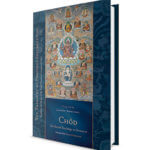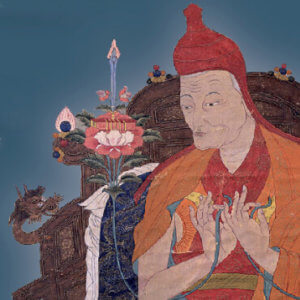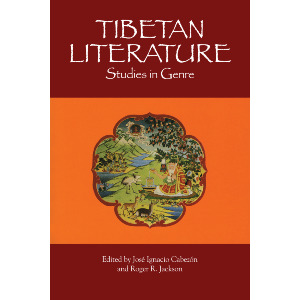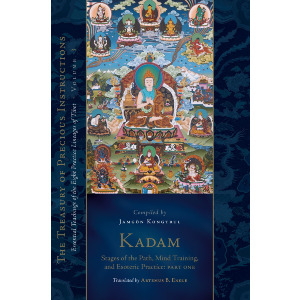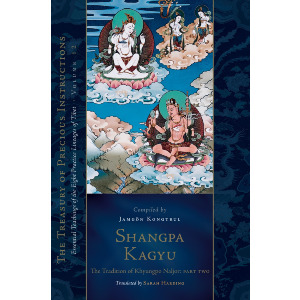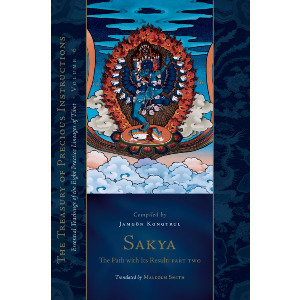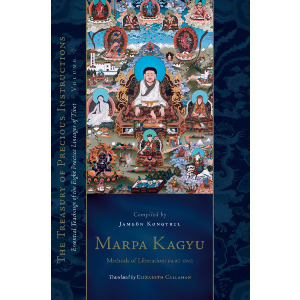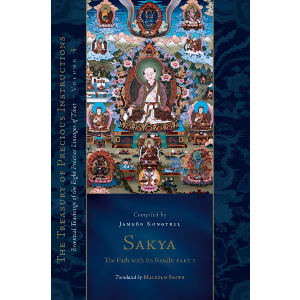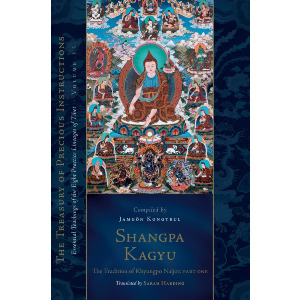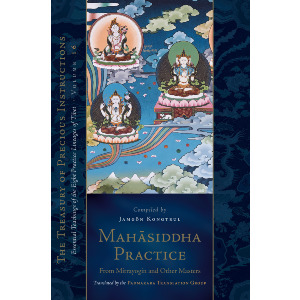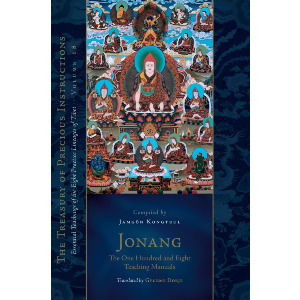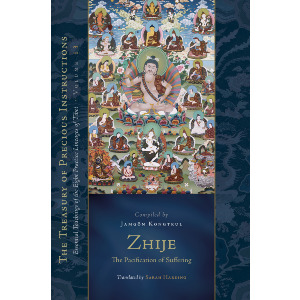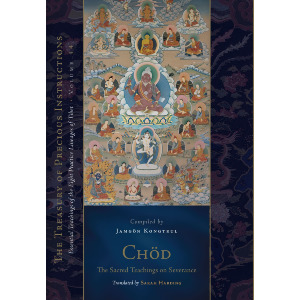The proliferation of lineages adhering to the teachings of Mar pa, those of his foremost disciple, Mi la ras pa (1040-1123), and those of the latter's main students Ras chung rDo rje grags (1083- 1161) and sGam po pa bSod nams rin chen (a.k.a. Dwags po Lha rje, 1079-1153) was very widespread, and the many teaching lineages that arose among their followers almost all created their own distinctive formulations of the bKa' brgyud gdams ngag. The four "great" bKa' brgyud orders (bKa brgyud che bzhi) were founded by sGam po pa's immediate disciples, among whom Phag mo gru pa rDo rje rgyal po's (1110-1170) leading disciples founded eight "lesser" orders (chung brgyad). (The terms"great" and "lesser" refer solely to their relative proximity to sGam po pa, and imply neither quantitative nor qualitative judgment.) The first Karmapa hierarch, Dus gsum mkhyen pa (1110-1193), is numbered among the four "greats," while 'Bri gung skyob pa 'Jig rten gsum mgon (1143-1217) was prominent among the founders of the eight "lesser" orders. Among the eight is also counted Gling rje ras pa Padma rdo rje (1128-1188), whose disciple gTsang pa rGya ras (1161-1211) founded the 'Brug pa bKa'brgyud order, which in turn gave rise to several major suborders. (The 'Brug pa later established itself as the state religion in Bhutan, a position it retains at the present time.) Mar pa bKa' brgyud teachings have been widely transmitted among non-bKa' brgyud pa orders, for instance among the dGe lugs pa, a considerable portion of whose esoteric gdams ngag originated in the Mar pa bKa' brgyud tradition.
- The Shangs pa bKa' brgyud, the "Succession of the Transmitted Precepts of Shangs Valley," is traced back to Khyung po rnal 'byor Tshul khrims mgon po of Shangs (d. ca. 1135), a master whose foremost teacher was the akinz Niguma, said to have been the sister or wife of Naropa. The special teachings of the Shangs pa tradition, which are similar to those of the Mar pa bKa' brgyud tradition, differing primarily in points of emphasis, were widely influential. Despite the almost complete absence of distinctive Shangs pa institutions, they were transmitted within the Mar pa bKa' brgyud, dGe lugs, Jo nang and rNying ma orders. The Shangs pa teachings have aroused considerable interest among Buddhists in the West owing to the widespread activity of their leading con temporary proponent, the late Kalu Rinpoche Rang byung kun khyab (1905-1989).
- The closely related teachings of Zhi byed, "Pacification," and gCod yul, "Object of Cutting," originated respectively with the enigmatic Indian yogi Pha Dam pa Sangs rgyas (d. 1117) and his remarkable Tibetan disciple, the yogini Ma cig Lab kyi sgron ma (ca. 1055-1143). Though schools specializing in Pacification were very widespread from the twelfth to fourteenth centuries, the teaching all but disappeared in later times. The Object of Cutting, however, permeated the entire Tibetan Buddhist tradition and is today preserved by all Both of these systems of gdams ngag seek to bring about the realization of liberating insight as it is un derstood in the "Perfection of Wisdom" (Prajfi.aparamita) sutras by means inspired by esoteric Buddhist practice. This takes par ticularly dramatic form in the traditions of the Object of Cutting, whose exquisite liturgies involve the adept's symbolic offering of his or her own body as food for all beings throughout the universe.
- rDo rje'i mal 'byor, the "Yoga of Indestructible Reality," refers to the system of yoga associated with the Kalacakra Tantra, as transmitted in Tibet initially by Gyi jo lo tsa ba Zla ba'i 'od zer during the early eleventh century. Later traditions that were particularly influential include those of Zhwa lu and Jo nang. The former came to be favored in the dGe lugs pa school, and contin ues to be transmitted in that order today, above all by H. H. the Fourteenth Dalai Lama. The latter fell into decline in the wake of the suppression of the Jo nang pa sect during the seventeenth cen tury, but was later revived in eastern Tibet, particularly by the proponents of the so-called Eclectic Movement (Ris med), during the nineteenth century.
- rDo rje gsum gyi bsnyen sgrub, the "Service and Attainment of the Three Indestructible Realities," represents an extremely rare tradition, closely allied with the Kalacakra Tantra, and stemmingfrom the teaching of the divine Vajrayogini, as gathered by the Tibetan siddha O rgyan pa Rin chen dpal (1230-1309) during his travels in the northwestern quarters of the Indian subcontinent. The teaching was popularized by O rgyan pa's successors during the fourteenth century, when several commentaries on it were composed, but subsequently seems to have lapsed into obscurity. 0 rgyan pa also figures prominently as a transmitter of several of the major bKa' brgyud lineages, notably the 'Brug pa and Karma pa traditions.
During the nineteenth century this scheme of the "eight great conveyances" provided the basis for the great Tibetan anthology of gdams ngag, the gDams ngag mdzod ("The Store of Instructions"), compiled by 'Jam mgon kong sprul Blo gros mtha' yas (1813-1899), one of the leaders of the Eclectic Movement. "The Store of Instructions" provides encyclopedic and balanced treatment of all of the major Tibetan Buddhist gdams ngag traditions and several of the more important minor ones, and preserves scores of instructional texts by some of the most famous Tibetan authors as well as by many who are less well-known. It includes in its compass en tire previous collections of gdams ngag materials, such as the Blo sbyong brgya rtsa ("The Hundred [Teachings on] Spiritual Training and Purification"), representing the essential gdams ngag of the bKa' gdams traditions ('Jam mgon, DNgDz, vols. 2-3), and the Jo nang khrid brgya dang brgyad ("The Hundred and Eight Guidebooks of the Jo nang pas"), an eclectic compilation by Jo nang rje btsun Kun dga' grol mchog (1507-1566) that is in certain respects a precursor to "The Store of Instructions" itself (DNgDz, vol. 12).
Because all of the traditions mentioned above have generated abundant literature devoted to their own distinctive gdams ngag, including both texts immediately concerned with the details of practical instruction and systematic treatises that attempt to formulate the distinctive perspective of a particular gdams ngag tradition in its relation to Buddhist doctrine broadly speaking, it will not be possible to attempt to survey here the extraordinary volume of materials that are illustrative of these many differing traditions. Indeed, one may well wonder at this remarkable proliferation of the Tibetan technologies of the self: if, after all, the goal is in any case the achievement of buddhahood here and now, then why complicate matters by providing those who wish to follow the path with such a dizzying array of road maps? The traditional view is that, like a well-equipped pharmacy, the Buddha's teaching provides appropriate remedies for the many different afflictions of living beings; the myriad gdams ngag of Tibetan Buddhism may thus be seen to constitute a spiritual pharmacopeia. The medi cal analogy, however, by suggesting that, to a certain degree at least, eclecticism and pluralism are to be welcomed for the therapeutic enrichment they provide, points to a complicated cluster of problems: briefly, how is one to form a comprehensive vision of the totality of possible approaches to the path, that remains sufficiently critical to exclude false paths, without at the same time undermining the positive values of pluralism? Kong sprul's eclectic and even unitarian approach to the difficulties that arise here finds its complement in the attempt to elaborate and defend favored systems of gdams ngag through doctrinal apologetics, whether these be relatively catholic in outlook, or narrowly sectarian. gDams ngag, essentially the pithy expressions of contemplative experience, thus become the basis for renewed dogmatic system-building. This occurred very prominently in certain of the schools of Tibetan Buddhism-consider in this regard the massive philosophical elaboration of the Great Perfection (rDzogs chen) teachings of the rNying ma school,15 or of the Great Seal (Mahamudra, Phyag chen) precepts of the several bKa' brgyud orders,16 or of the originally bKa' gdams pa Path Sequence (Lam rim) instructions among rJe Tsang kha pa and his successors.17 The products of these and other similar doctrinal syntheses certainly represent some of the most creative developments in the field of Tibetan Buddhist thought. The exploration of the many ramifications of such system-building, however, lies beyond the scope of this small contribution.
In order to provide the reader with a concrete example of the teaching of a particular tradition of gdams ngag, I give below, in the manner of an appendix, some short translated excerpts from "The Hundred and Eight Guidebooks of the Jo nang pas," concerning the history and the actual teaching of the practical dimen sion of the approach to Madhyamaka thought known as dBu ma chen po ("The Great Middle Way"). It is important to recall that gdams ngag traditions are not thought of ahistorically in Tibet: each such tradition has its unique origin, history of transmission, and relevance to a special historical setting. Thus, even a very terse historical note, such as the one given here, helps to situate a given gdams ngag for the Tibetan reader or auditor. The equally terse presentation of the teaching itself reflects what is in fact a series of rubrics, intended to guide an expanded course of oral explanation. The strictly maintained correlation between history and doc trine reinforces the role played by these instructions as the practi cal technologies of the self, for in a tradition's history we find the concrete exemplifications of the human ideals that are to be real ized by one's submission to the course of training imposed by that same tradition's gdams ngag.
I have chosen this particular extract to honor Geshe Lhundrup Sopa, to whom the present volume is dedicated, for Geshe-la has been a preeminent exponent of Madhyamaka thought through out the nearly three decades that he has graced Buddhist Studies in the special setting of our own time and place. Those who have had the good fortune to study with him will no doubt supplement the topics briefly enumerated here with their own recollec tions of Geshe-la's learned expositions of related subject matter.
From the "History of the Hundred and Eight Guidebooks":
Concerning the dBu ma chen po'i khrid ["The Guidance on the Great Middle Way"]: it was received by the bodhisattva Zla ha rgyal mtshan from the Newar Penya pa, one who belonged to the lineage of Nagarjuna, father and son [i.e., Nagarjuna and Aryadeva]. He taught it to rDzi lung pa 'Od zer grags pa, and he to Gro ston, who propounded it widely. There are some who hold that this was the lineage of the dBu ma lta khrid ["The Guidance on the View of the Middle Way"] that came to the venerable Re mda' ha from mNga' ris, in West Tibet, but that is uncer tain. This is [also] called the gZhung phyi mo'i dbu ma ["The Middle Way according to the Original Texts," i.e., of Nagarjuna and Aryadeva], and so is the ancient tradition, not yet divided into Prasangika and Svatantrika. That which is distinguished as the special doctrine of Red mda' ha, however, is the unblemished adherence to the Prasangika tradition, that follows the texts of the glorious Cand rakirti.
From the "Text of the Hundred and Eight Guidebooks":
dBu ma chen po'i khrid yig ["The Guidebook of the Great Middle Way"]: Concerning "The Guidance on the Great Middle Way": One begins by going for refuge and cultivating the enlightened attitude [bodhicittaJ. Then, investigating the abiding nature of appearance and emptiness, appearance is [determined to be] just this unimpeded and ever-varied arising. As for the understanding of emptiness, however, it is neither the emptiness that follows after a pot has been shattered, nor is it the emptiness that is like the pot's emptiness of being a blanket, nor is it the emptiness of sheer nothingness, like that of a hare's horn. It is, rather, self-presenting awareness's emptiness with respect to substantial essence at the very moment of appearance. And that, because it is empty of veridicality in terms of the relative, is apparition-like, and, because it is absolutely empty of essence, is sky-like. In brief, whatever the manner of appearance, there is not even so much as the tip of a hair that is veridically estab lished. This is not the emptiness of [appearance's] cessation, nor the emptiness of the fabricated. It is precisely the emptiness that has reference to appearance itself.
When cultivating this experientially, you adopt the bodily disposition of the meditational posture. First you consciously strive somewhat [to recall and to concentrate upon the understanding of appearance and emptiness taught above]. In the end you re lax [that deliberate striving]. Beginners should practice frequently in short sessions.
When you have thus cultivated the meditation, the three spiri tual experiences of clarity, bliss and nonconceptuality arise. It will come about that mind will not grow excited about that at all, but will remain at ease, like the hand resting just where you place it. Your awareness becomes absorbed in simplicity, in the simple disposition of reality. (1) The inception of one-pointed ness that remains unexcited with respect to [both] untarnished clarity of mind and circumstantial objects is called "tranquil ity" (samatha, zhi gnas) while (2) its nonconceptual nature, like the circle of the sky that is free from apprehended referent, is called "insight" (vipasyana, lhag mthong). (3) Complete absorption is untouched by the intellect that apprehends objectives, and (4) your course of conduct involves the awareness of the qualities of dream and apparition in the aftermath [of meditative absorption]. You experientially cultivate [this teaching] in these four ways. When hairline discriminations of being and nonbeing forcefully arise, you gradually develop your skill, and it is said that in this way you will come to meet the face of that abiding nature that is unpolluted by the taints of the conceptual elaborations of the eight limitations.
The heart of all [kun] doctrines is the Great Middle Way: To delight [dga'] the wise, it is completely free [grol] From the range of unreflective and foolish meditations;
It is the great path of supreme [mchog] freedom from limitations.21
This was compiled from the guide[book] of the bodhisattva Zla [ba] rgyal [mtshan ).

